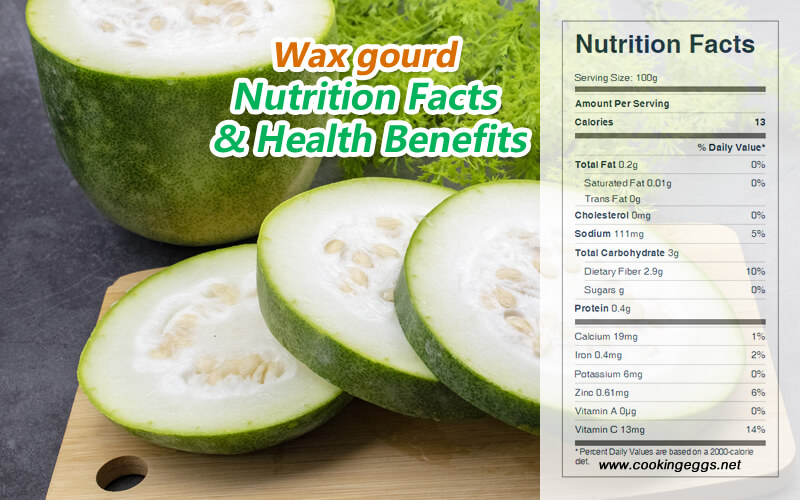Wax Gourd Nutrition Facts and Health Benefits
Warning: A non-numeric value encountered in /www/wwwroot/www.cookingeggs.net/wp-content/plugins/nutrition-facts-label/nutrition-facts-label.php on line 384
Wax gourd, also called ash gourd, white gourd, winter gourd, winter melon, or Chinese preserving melon, is a vine grown for its very large fruit, eaten as a vegetable when mature. The name "wax gourd" was derived from the color of the gourd’s skin, which is similar to the color of ash.
The wax gourd originated in South Asia and is widely grown throughout South and Southeast Asia, including Myanmar, Malaysia, China, Japan, and almost all countries in Southeast Asia as a prominent crop. Since it cannot survive extreme cold, it is not grown in Western countries.

Nutritional Value of Wax gourd
Raw wax gourd is 96% water, 3% carbohydrates, 0.4% protein, and contains negligible fat.
Each 100 g of wax gourd contains 13 kcal of energy, 0.2 g of fat, 3 g of carbohydrates, 2.9 g of fiber, 0.4 g of protein, 13 mg of vitamin C, 0.1 mg of riboflavin, 0.4 mg of niacin, 5 g of folate, 0.13 mg of pantothenic acid, 19 mg of calcium, 0.4 mg of iron, 10 mg of magnesium, 19 mg of phosphorus, 6 mg of potassium, 111 mg of sodium, 0.6 mg of zinc, and 0.06 mg of manganese.
Wax gourd fruit is high phytochemical content. These include carotenoids, peptides, phenolic sterols (lupeol, lupeol acetate, betasitasterol), triterpenes (alnusenol, multiflorenol, isomultiflorenol), and uronic acid. It is valued for bioactives and therapeutic agents such as triterpenes, phenolics, sterols, glycosides, and soluble dietary fiber.
Raw Wax Gourd Nutrition Facts Label
Health Benefits of Wax gourd
Many vegetables are excellent sources of essential phytochemicals that are beneficial to health and in the delay and prevention of diseases that have inflicted humankind. Wax gourds are commonly consumed as vegetables and used for making sweets. Wax gourd is rich in carotenoids, peptides, phenolics, triterpenes, and uronic acid. It is also rich in vitamins and minerals.
It seems that the majority of the beneficial effects of wax gourd appear to be due to the flavonoids, polyphenolics, and carotenoid contents of this vegetable.
The edible portion of wax gourd has a high moisture content and is low in fat. Apart from macronutrients, vitamins and minerals are the essential nutrients found in wax gourd. It is very low in calories and rich in dietary fiber, which helps with overall health and wellness.
Wax gourd has been found to have hypoglycemic and hypolipidemic effects in diabetes by causing a 42% decline in blood glucose levels after 21 days of administration. In a study, supplementation of wax gourd juice to dyslipidemic subjects for 45 days revealed a small increase in high-density lipoprotein cholesterol, a decrease in very low-density lipoprotein cholesterol, an increase in the serum cholesterol/HDL cholesterol ratio, and a decrease in the triglyceride/HDL cholesterol ratio.
Wax gourd contains certain active components, such as terpenes, flavonoid C-glycosides, and sterols, that have antioxidant effects, which in turn can inhibit gastric mucosal injury by scavenging the free radicals with increased production of superoxide dismutase and vitamin C.
The higher antioxidant capacity of the seed may result from the higher total phenolic content and superoxide dismutase activity. A study has shown that the seeds of the wax gourd have a higher amount of phenolic content compared to pulp, and the seeds are known to provide greater antioxidant activity than pulp, owing to their higher total phenolic content and superoxide dismutase activity. These functions of wax gourd may be responsible for the antioxidation and inhibition of ACE activity, which may provide protective effects against cardiometabolic diseases and cancers. The antioxidation properties and ACE activity inhibition of wax gourd can provide protective effects against such major non-communicable diseases as obesity, diabetes, cardiovascular disease, and cancer.
Wax gourd can also protect the body from peptic ulcer and hemorrhage, and it possesses antibiotic and purgative vermifuge properties. It is also beneficial as an antibiotic and a purgative vermifuge for cough and fever and in treating heart, liver, and kidney diseases and disorders.